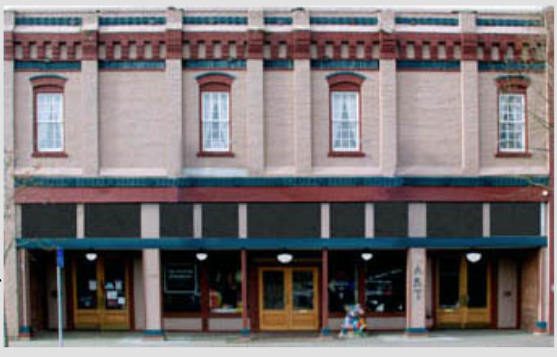WE TEND TO THINK OF “CULTURE” AS SOMETHING THAT HAPPENS IN BIG SPACES in big metropolitan areas, places like the Metropolitan Museum of Art and the Metropolitan Opera, or the Portland Art Museum and the Portland Opera. But every corner of the country, and every region of Oregon, has a culture of its own, and the drive to express it, in spaces that may be much smaller but are equally important in their communities. They might be cultural centers, like the Pendleton Center for the Arts, or small museums, like the Favell Museum in Klamath Falls, or historic small theater spaces, like the Elgin Opera House in the far stretches of Northeastern Oregon. In an age of freely flowing information around the globe, sometimes smaller places bring the outside world in. Sometimes they highlight their own local culture, the things that make their communities specifically what they are.

Like most museums and performance spaces across the United States, the Grants Pass Museum of Art in Southern Oregon is shut down for the duration. The museum isn’t very big – it’s on the second floor of a historic building in downtown Grants Pass – but it’s a crucial part of its community, with a permanent collection, a small retail gallery, workshops for kids and adults, music, poetry readings, and an ordinarily full schedule of special exhibitions. Just when it might reopen is up in the air: The museum’s two large open galleries would allow ample space for social distancing, but traffic on the stairway from the building’s first floor would need to be strictly controlled. It’s the sort of logistical issue that most cultural organizations, from the biggest to the smallest, are grappling with as they wait for the go-ahead to reopen.
“The big issue we are currently facing has to do with exhibits,” Hyla Lipson, the museum’s executive director, said in an email exchange. “We have artists scheduled, but since the normal activities are not allowed (First Friday, which engages anywhere from 200-500 people in one three-hour period), artists talks, receptions – we are concerned that the exhibiting artists will not get the traffic they would normally see.” And of course, that assumes that anyone’s allowed to see anything at all. The museum has decided it won’t reopen until at least July and maybe August; health concerns and state rulings could make it even later.
Among other things, the shutdown closed the door on the latest version of a traditional and eagerly anticipated show. “For forty years there has been an exhibit called Best of the Best, which includes students’ art from high schools in Southern Oregon,” Lipson said. “It’s partially sponsored and coordinated by Southern Oregon University. The exhibits rotate every year from the SOU museum to the Rogue Gallery in Medford to the Grants Pass Museum of Art. This was to be ‘our’ year and we were very excited. It’s a lot of work because 14 schools have the opportunity to bring ten pieces of the students’ work, making a potential exhibition of 140 pieces. We actually have extra partitions we install to allow for more wall space for the exhibit.
“The art was supposed to be delivered on March 30. With the governor’s announcement, we had to close our doors on March 23. What to do – what to do? The students look forward to this exhibit and we wanted to honor them as well as the teachers who encourage their creativity. So, we decided to have a virtual exhibition. We called it Virtually, the Best of the Best. We had each art teacher take pictures of their students’ art and send us the images. … I then contacted a woman who I had recently met (timing is everything) who is a digital wizard and asked her if she could put together a creative slide show. As an aside, she works for the Central Point School District and was really excited to showcase the students. In the end, nine schools participated. … We feel that we have reached a large audience and that the students have had their work showcased even though the actual event couldn’t happen.”
And here it is, virtual but real – a slice of Southern Oregon’s own culture, and a taste of its future. The links above and on the photo below will take you to the full 24-minute video. This one will give you the handy dandy, four-minute condensed version. One way or another, art finds a way:


MEANWHILE, BACK AT THE ISOLATION RANCH …
AS HARDBALL POLITICAL PLAYERS TWIST THE COVID-19 INTERNATIONAL HEALTH CRISIS into the shape of the Great American Cultural Divide, a slow and wary thaw is also taking place. The number of deaths from the virus in Oregon has dropped sharply in the past week, although the number of reported cases of infection has continued to rise, and health experts continue to warn both that the first wave of the pandemic hasn’t ended, and that the second wave could be more fatal than the first. Still, the state is cautiously opening up after its long lockdown: Multnomah County, the last county in Oregon still on full lockdown (and still, because of its population density, the state’s epicenter of infections) is aiming for a Phase 1 reopening on June 12. Some other parts of the country are moving much farther, much faster. In Florida, the high-volume, close-contact entertainment juggernaut Disney World, with huge profits at stake, wants to reopen in July. The sports world is champing at the bit: Professional basketball and college football, both high-personal-contact sports and both with hundreds of millions of dollars on the line, are pushing hard to get the games going in spite of the medical risks.
It’s not hard to understand why. Unquestionably the pandemic has shredded economic stability. Millions of people are suffering, many with little hope that their jobs will return. The arts and entertainment industries and the restaurant world, which is closely linked, are particularly hard-hit. Buried under rising costs and little or no income, many once-thriving restaurants – including David Machado’s string of upscale spots and the dim sum palace Wong’s King Seafood – are shutting down permanently. Workers at Oregon arts organizations large and small are furloughed or laid off, with no guarantee that the companies they work for will survive: However and whenever the pandemic ends, the cultural landscape is going to look very different. Jim Brumberg, co-owner of the Portland music venues Mississippi Studios and Revolution Hall, published a recent guest editorial in The Mercury urging readers to lobby state and federal officials to rev up financial assistance for struggling independent music spaces. (On the whole, public assistance to arts organizations has lagged behind the sector’s share of actual impact on the national economy.) And a recent poll in New York suggests that, even if Broadway theaters open their doors again soon, a high percentage of theatergoers will be reluctant to buy tickets and take their seats. That attitude is highly likely to be adopted in Oregon, too.
Hold onto your hats. Even in Oregon, which has been hit less hard than much of the nation, this thing’s far from over – and jumping the gun can only make things worse.
DRUMMING UP A FEW GOOD STORIES TO READ

Portland drummer and composer Barra Brown. Photo: Reed Ricker
BARRA BROWN’S SENSE OF URGENCY. Brett Campbell profiles the prolific Portland drummer and composer, whose projects range far and wide. In 2015 he dedicated his album Dreaming Awake to a family friend who was dying of cancer. “Since then, Brown, now 30, has unleashed a flood of music in varied styles, playing various instruments, as though he needs to try everything now and take it as far as he can — before it’s too late,” Campbell writes.
FORTEPIANOS AND A MISTY LAKE IN THE MOONLIGHT. Pianist Joseph Albert writes about the historic progression from harpsichord to fortepiano to modern piano, and how the way we hear a piece of music – in this case, Beethoven’s ‘Moonlight’ Sonata – can depend on the instrument it’s played on. Which leads to …
THE WOMAN AT THE HEART OF BEETHOVEN’S ‘MOONLIGHT’ SONATA. Patricia Morrisroe tells the story for The New York Times of how she came to write a new novel based on Beethoven’s apparent infatuation with a beautiful student, and how he came to dedicate one of his most famous compositions to her. (I like the print edition headline, Beethoven Rolled Over for Her, better.)
A CHANCE ENCOUNTER AND A FLOOD OF MEMORIES. A conversation on a MAX commuter train takes writer Stephen Rutledge on a ride into Portland racial history and one woman’s life of beauty, elegance, and endurance. His accidental seatmate? Cora Smith, who grew up in Vanport before the Memorial Day flood of 1948 wiped the city, in what’s now the Delta Park area of North Portland, off the map. Smith later became a model, a fashion and beauty consultant, a business owner, a television host, and a leader in Portland’s Black community. (Meanwhile, the Vanport Mosaic 2020 Virtual Festival steams toward its conclusion Sunday, with daily online attractions including Saturday’s Vanport Day of Remembrance and Sunday’s Gambatte! Legacy of an Enduring Spirit: Japanese American Incarceration, Then and Now, with photojournalist Paul Kitagaki Jr.)
‘WE LOVED EACH OTHER’: FAUCI RECALLS LARRY KRAMER, FRIEND AND NEMESIS. Kramer, the sharp-edged, confrontational AIDS activist and writer who forced awareness of the epidemic on a reluctant public in the 1980s and demanded action – his play The Normal Heart was a landmark artistic response to the crisis – died early Wednesday at age 84. He forged an unlikely and long-lasting friendship with Dr. Anthony S. Fauci, at the time the nation’s best-known AIDS doctor and now the nation’s chief medical spokesman during the coronavirus crisis. It wasn’t easy. Kramer had called Fauci “a murderer and an incompetent idiot” on the front page of the San Francisco Examiner magazine, Fauci recalled to Donald G. McNeil Jr. for this New York Times story. Opposites attracted, and maybe they weren’t so opposite, after all.
FINAL CALL FOR A NEWPORT ORIGINAL. Art by the late Newport arts mover and shaker Juergen Eckstein, who died last fall, is among the works available in the Oregon Coast Online Art Show, Lori Tobias writes. The show, which goes live Friday and continues through Sept. 7, is a benefit for the Oregon Coast Council for the Arts.
ACCOUNTS TO FOLLOW: NATURAL REFRESHMENT. In the first of a series about Oregon artists to follow on Instagram, Shannon M. Lieberman talks with Katy Abraham, Stirling Gorsuch and Aimée Brewer: “Their Instagram accounts capture both the teeming energy and quiet strength of nature and allow us to experience a sense of the outdoors wherever we may be.”

Katy Abraham, “Where You Left Me.” Watercolor on paper. 9 x 12 inches. Image courtesy of the artist. Instagram account: @cascadiaartproject
QUOTABLE (ON ART AS A FREIGHT TRAIN)
“And I can tell you right now that painting went through me like a freight train. I don’t know if I was shaking on the outside, but I was shaking on the inside. I was mesmerized.”
– John Driscoll, recalling his first view of Rembrandt’s Lucretia, at the Minneapolis Institute of Art, when he was 10. As quoted in his obituary in The New York Times. Driscoll, owner of New York City’s oldest art gallery, which opened in 1852, died on April 10 at age 70, from the effects of Covid-19.
Give today. Keep the stories coming.
OREGON ARTSWATCH WELCOMES YOUR HELP during the coronavirus crisis. Your donation at this critical time will go toward the Full Circle Fund to provide free ads to all cultural nonprofits in Oregon and Southwest Washington for one year. Every dollar raised will be magnified six times.
Become a member. Make a donation.
Just press the “donate today” button below.

































